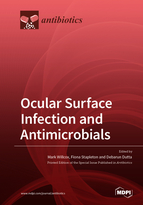Ocular Surface Infection and Antimicrobials
A special issue of Antibiotics (ISSN 2079-6382). This special issue belongs to the section "Antibiotics Use and Antimicrobial Stewardship".
Deadline for manuscript submissions: closed (31 May 2022) | Viewed by 27454
Special Issue Editors
Interests: development of antimicrobial surfaces; new antimicrobials; bacterial resistance mechanisms; new treatments for infections
Special Issues, Collections and Topics in MDPI journals
Interests: contact lenses; ocular surface; dry eye; ocular microbiology; corneal infection
Special Issues, Collections and Topics in MDPI journals
Interests: ocular surface infection; ocular microbiology; contact lenses; novel antimicrobial agents; keratitis
Special Issues, Collections and Topics in MDPI journals
Special Issue Information
Dear Colleagues,
Infection of the ocular surface can have devastating consequences if not appropriately treated with antimicrobials. The ocular surface can be infected by bacteria, fungi, viruses and protozoa. These infections can lead to blindness or evisceration of the globe. Treatment often needs to be fast, empirical and based on presentation of the disease. However, infection by different microbes can manifest similarly and so initial treatment may have to be changed. Furthermore, microbes causing infections are showing increasing resistance to antimicrobials. These delays can worsen outcomes.
This Special Issue seeks to examine the susceptibility of ocular surface isolates from different geographical areas to current and new antimicrobial agents. Clinical trials, observational studies, case series reports, laboratory studies, systematic reviews and meta-analyses providing new insights into the antibiotic treatment of ocular surface microbial infections are encouraged. Data on the effect of antimicrobial resistance to clinical outcome are especially encouraged.
Prof. Mark Willcox
Prof. Fiona Stapleton
Dr. Debarun Dutta
Guest Editors
Manuscript Submission Information
Manuscripts should be submitted online at www.mdpi.com by registering and logging in to this website. Once you are registered, click here to go to the submission form. Manuscripts can be submitted until the deadline. All submissions that pass pre-check are peer-reviewed. Accepted papers will be published continuously in the journal (as soon as accepted) and will be listed together on the special issue website. Research articles, review articles as well as short communications are invited. For planned papers, a title and short abstract (about 100 words) can be sent to the Editorial Office for announcement on this website.
Submitted manuscripts should not have been published previously, nor be under consideration for publication elsewhere (except conference proceedings papers). All manuscripts are thoroughly refereed through a single-blind peer-review process. A guide for authors and other relevant information for submission of manuscripts is available on the Instructions for Authors page. Antibiotics is an international peer-reviewed open access monthly journal published by MDPI.
Please visit the Instructions for Authors page before submitting a manuscript. The Article Processing Charge (APC) for publication in this open access journal is 2900 CHF (Swiss Francs). Submitted papers should be well formatted and use good English. Authors may use MDPI's English editing service prior to publication or during author revisions.
Keywords
- ocular surface infection
- antimicrobial
- keratitis
- conjunctivitis
- Acanthamoeba
- antibiotic resistance
- fungal infection
- viral infection
- contact lenses









